How much have you already used the PFF Mock Draft Simulator? For me, the answer would be considerably more than 300,000 times.
Of course, I have drafted for my team only a few (dozen) times, but my CPU kept running overnight to simulate the draft over and over again. While just letting the simulation do its thing is neither particularly entertaining nor enlightening on a single run, doing it repeatedly and summarizing the results can yield interesting information. Among other things, it allows us to compare forecasted draft position ranges.
This is especially true for our version of the simulator, as the customization allows us to simulate the draft with different settings and investigate the differences in results.
[Editor’s note: Check out PFF’s 2020 Mock Draft Hub, NFL Draft Big Board and NFL Mock Draft Simulator. PFF Elite subscribers can also download the 1,100-page 2020 NFL Draft Guide.]
In this article, we want to present results from simulating the first three rounds of the draft, find out which teams are positioned to get more out of their draft capital and even take a stab at forecasting steals and reaches.
Simulating the top of the draft from the prospect’s view
The following chart shows the distribution of draft spots for the 12 prospects with the highest average draft position when using the standard settings (a 50:50 blend of the PFF Draft Big Board and the public’s board).
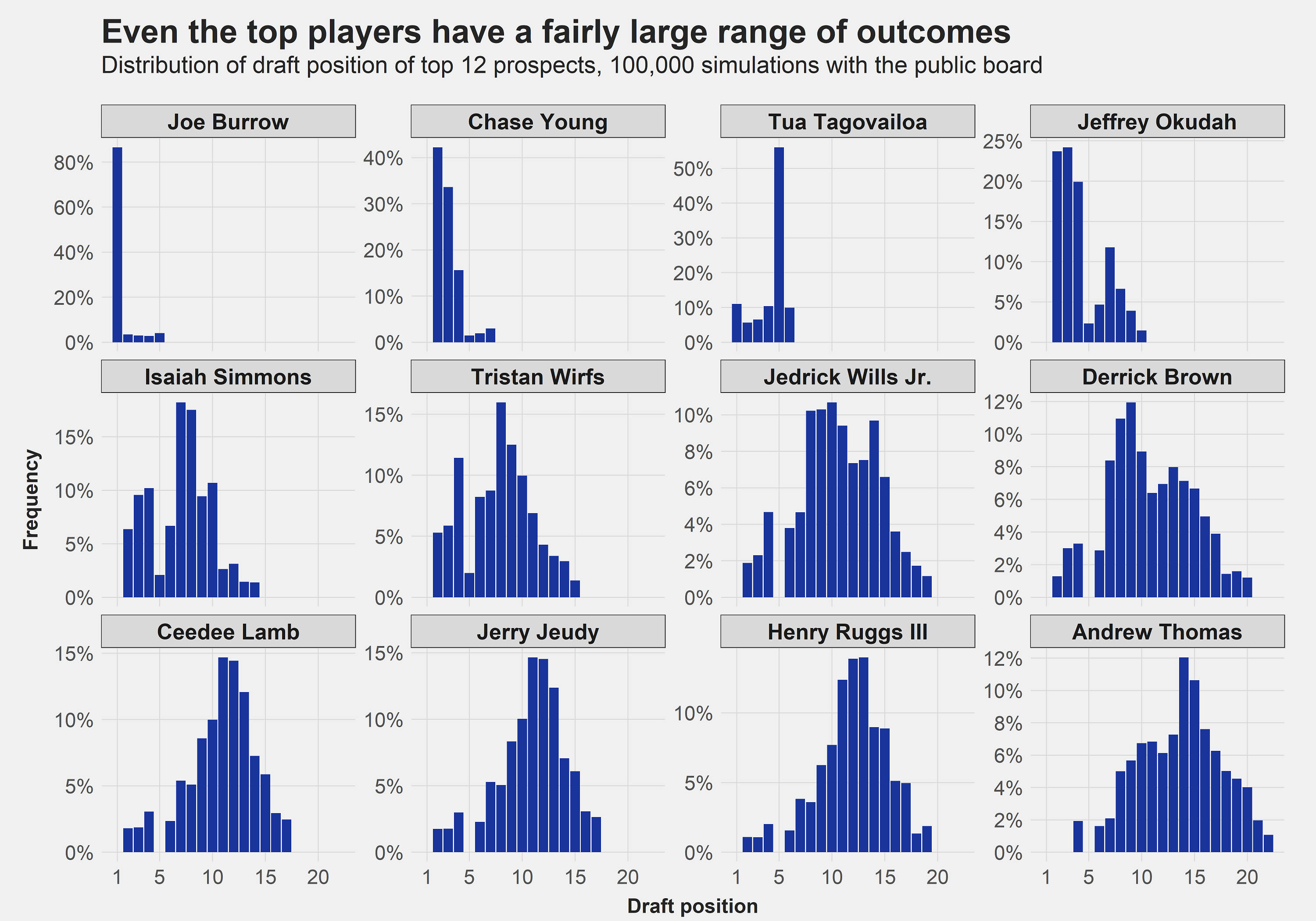
While quarterbacks are somewhat an anomaly, we can see that players generally face a fairly large range of outcomes, even at the top of the draft. Every year, there are exceptions like Chase Young, a player many people can’t even comprehend dropping even as low as No. 3. The simulation has a little bit more uncertainty cooked in, as a team trading up for a quarterback or Washington falling in love with a valuable player like Jeffrey Okudah is still a realistic option. After all, Okudah also fills the Redskins’ primary offseason need. Nevertheless, the simulation can’t really imagine Young falling out of the top four.
The three top receivers are kind of a unicorn in that regard, as their distributions observe a clear peak around the 11th or 12th pick of the draft. The reason for this is mainly that this fits not only their range on the public board, but there is also a three-pick stretch of teams with a need at the wide receiver position: the New York Jets, Las Vegas Raiders and San Francisco 49ers. If Jeudy, Lamb or Ruggs make it this far, they most likely won’t fall any further.
We can also look at the likelihood of being a top-five or top-10 pick for the best prospects:
| Prospect | Top-five pick? | Top-10 pick? |
| Joe Burrow | 100% | 100% |
| Chase Young | 94% | 100% |
| Jeffrey Okudah | 70% | 99% |
| Tua Tagovailoa | 90% | 100% |
| Justin Herbert | 39% | 98% |
| Isaiah Simmons | 28% | 91% |
| Tristan Wirfs | 25% | 80% |
| Mekhi Becton | 12% | 55% |
| Jedrick Wills Jr. | 10% | 49% |
| Derrick Brown | 8% | 51% |
| Jerry Jeudy | 7% | 38% |
| CeeDee Lamb | 7% | 38% |
| Henry Ruggs III | 4% | 27% |
| Andrew Thomas | 4% | 25% |
| C.J. Henderson | 2% | 16% |
| Javon Kinlaw | 1% | 16% |
With Chase Young and the top two quarterbacks in Joe Burrow and Tua Tagovailoa, we have three top-five locks. Jeffrey Okudah, Isaiah Simmons and Justin Herbert join them as top-10 locks. Any other player has a pretty realistic chance of falling out of the top 10.
We should note that neither our board nor the public board (as of April 11) has reacted to recent reports that teams are more scared of investing in Tagovailoa than we first thought, which is a possible side effect of the unusual draft preparation due to the COVID-19 pandemic. On the one hand, this could mean that the projections for Tua’s draft position are not accurate. On the other hand, this could be just a smokescreen.
At this point, we simply don’t know which one it is, and this is a clear positive for providing a relatively large range for the draft position of single prospects in the Mock Draft Simulator.
The team’s view
Instead of focussing on where a prospect will land, we can also focus on who we think each team will draft and show the five most likely candidates for each draft pick of the first round in our simulations using the public board.
While the five most likely candidates make up almost all of the candidates at the top of the draft, there’s a lot more uncertainty later in the first round (and even more so on Day 2).

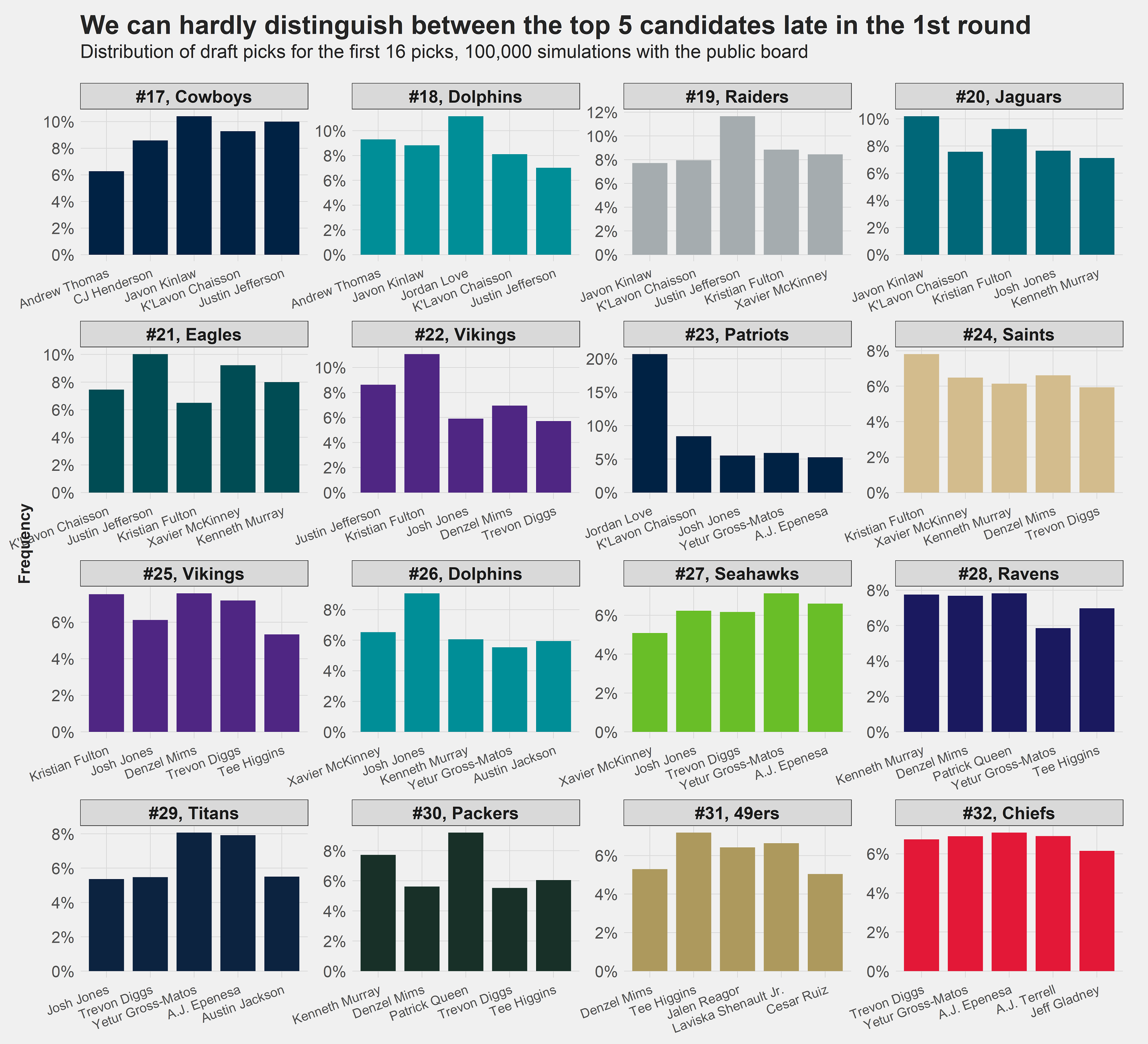
Differences between PFF and the Public
Just like every year, there are some players whose evaluations are over the place. In particular, we at PFF might be higher or lower on players than the public is. The beauty of the draft is that in each single case, we have no idea whether we or the public is on the wrong side of the evaluation.
Recent examples swing both ways: In 2018, we were lower than the public on linebacker Tremaine Edmunds — PFF rank of 30 compared to the public’s expected draft position (EDP) of 9.6 — and two years later it looks like this wasn’t a bad decision. Public mock drafts have shown Derwin James with exactly the same EDP of 9.6, while in hindsight, his PFF rank of 5 better reflects the impact he has had in the NFL so far.
It wouldn’t be fair to also omit our misses. After a disastrous Combine performance, we were a bit too harsh on Orlando Brown Jr., ranking him 86th, while the public had him fall “only” to 59th. After grading out well two years in a row, Brown is on a clear path to prove us wrong. On the flip side, occasionally we are too high on a prospect: Connor Williams hasn’t yet shown he was worth being ranked 18th overall on our 2018 big board, though there is some hope left as Year 3 or 4 is the general breakout year for offensive linemen.
Not knowing who got it better this year, here are the largest discrepancies between PFF’s Big Board and the public’s big board, with differences measured by the PFF draft value chart.
PFF Favorites
|
Player |
PFF board median draft position | Public board median draft position | Difference in draft value |
| Jordan Elliott | 26 | 85 | 0.31 WAR |
| Michael Pittman Jr. | 21 | 68 | 0.31 WAR |
| Curtis Weaver | 29 | 65 | 0.23 WAR |
| Willie Gay Jr. | 41 | 96 | 0.23 WAR |
| Ashtyn Davis | 36 | 74 | 0.20 WAR |
| Jonah Jackson | 42 | 89 | 0.20 WAR |
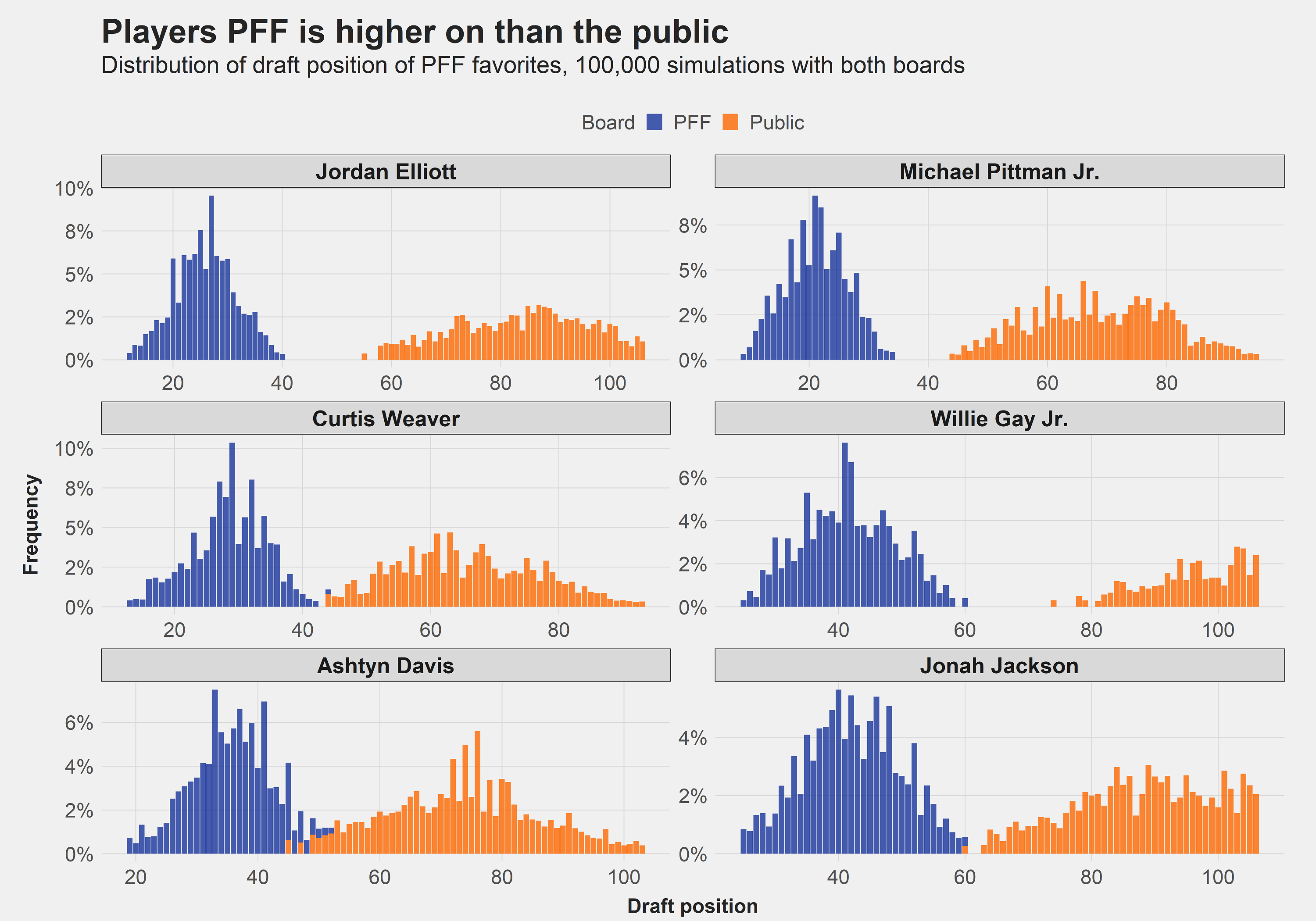
Other notable PFF favorites: Jonah Jackson, Tyler Johnson, Kristian Fulton, Grant Delpit, Netane Muti.
Public Favorites
|
Player |
PFF board median draft position | Public board median draft position | Difference in draft value |
| Mekhi Becton | 46 | 10 | -0.42 WAR |
| Justin Herbert | 23 | 6 | -0.40 WAR |
| Jordan Love | 69 | 18 | -0.33 WAR |
| Austin Jackson | 91 | 32 | -0.29 WAR |
| Kenneth Murray | 64 | 26 | -0.25 WAR |
| Yetur Gross-Matos | 19 | 10 | -0.16 WAR |

Other notable public favorites: K’Lavon Chaisson, D’Andre Swift, Jeremy Chinn, Jonathan Taylor, Derrick Brown.
Draft capital, steals and reaches
We’ve simulated the first three rounds of the draft and can, of course, assign draft capital to each team using only their picks from the first three rounds.
This draft capital is computed with the generic WAR value of each pick in the draft, as computed with a model incorporating the drafts from 2006 to 2016. It might be interesting to see whether our specific PFF consensus WAR projections (explained here) combined with our simulations yield different results for individual teams. For that matter, we throw away all quarterback picks (WAR projection of quarterbacks are generally higher) and compare the draft capital to the average WAR projections the teams gained in our simulations.
The correlation coefficient of the two measures is 0.98, an encouraging result for the stability of the draft value chart going forward, as there is no inherent relationship between those two numbers. If the draft value chart were noisy, we wouldn’t expect such a high correlation.
In particular, most teams are projected to gain as many WAR as we would have expected, given their draft slots. However, there are still a few teams positioned to gain more or less WAR than their draft position would suggest.
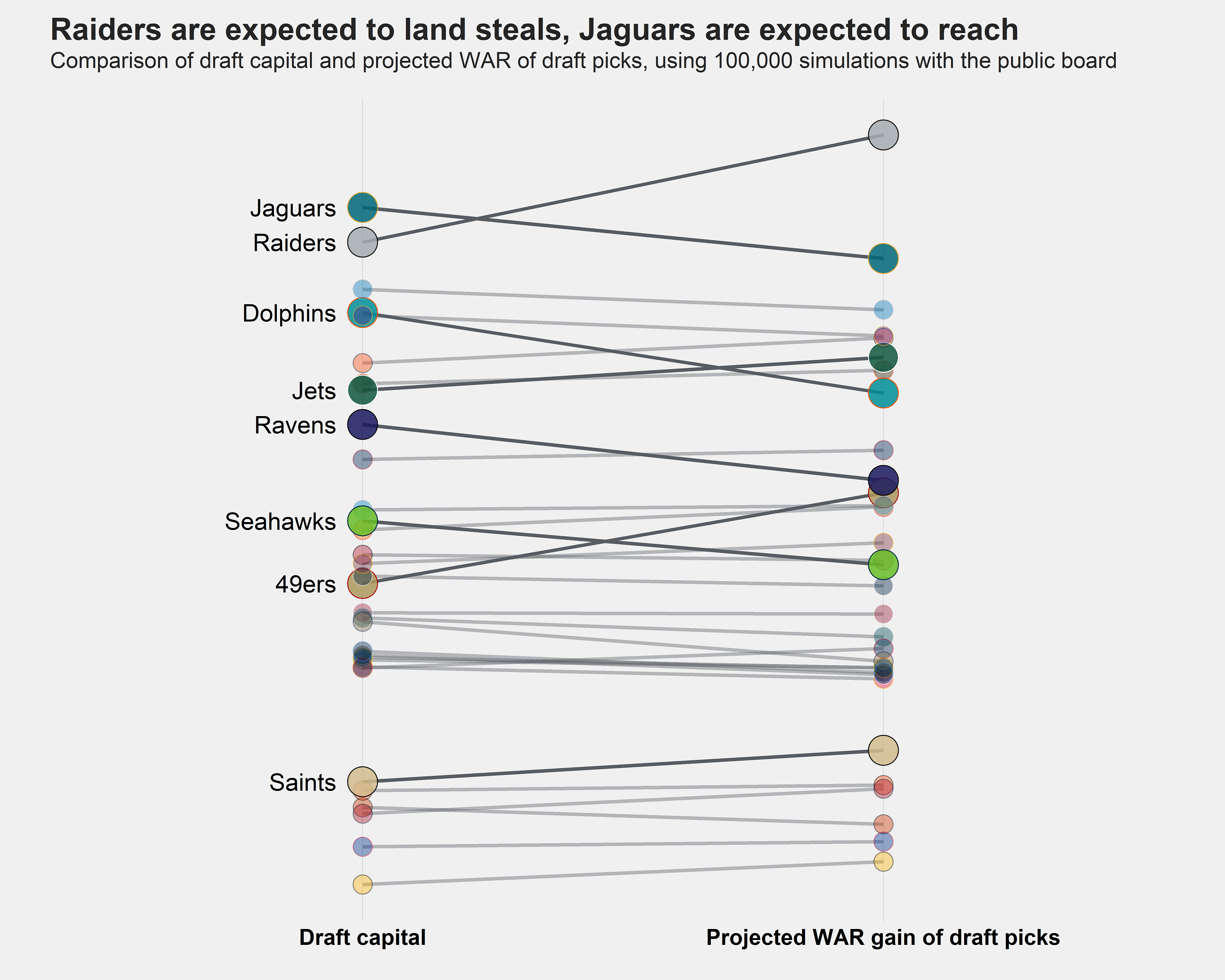
The Jacksonville Jaguars are expected to come away with less, mostly because their need at the interior defensive line could have them draft Derrick Brown and their need at offensive tackle could have them draft Mekhi Becton — both of whom might still be available at No. 9.
The New York Jets also have a need at offensive tackle, but with many other teams needing a tackle in front of them, they are in the (from our perspective) lucky situation that Becton is already off the board more often than not.
The Las Vegas Raiders are projected to make the most out of their draft capital, mostly because they are likely to end up with one of the top three receivers at No. 12 and are well-positioned to finally add to their secondary with the 19th pick of the draft.
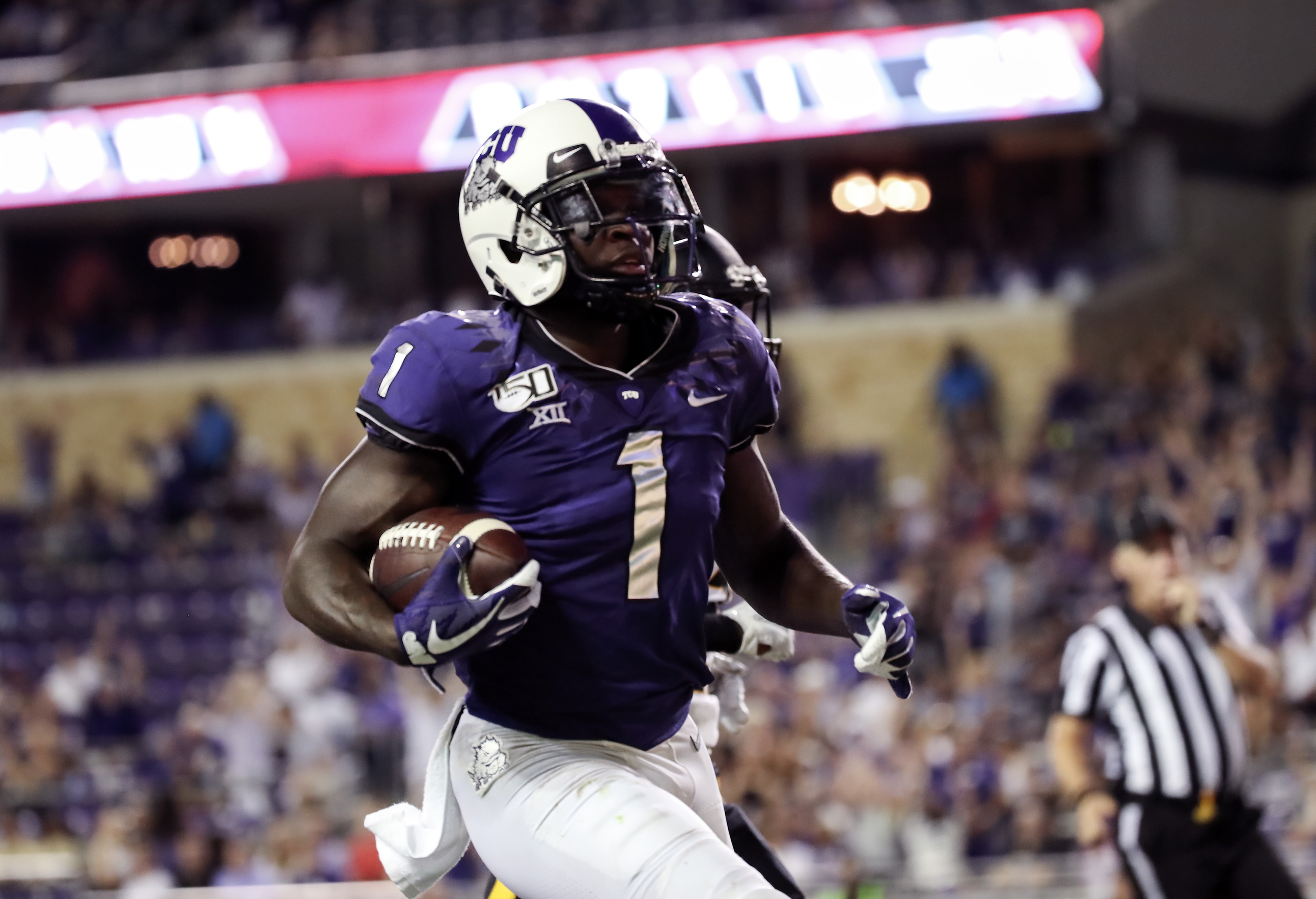
We also want to take a look at individual steals or reaches. Which teams might have a valuable player fall in their laps? And which teams are in danger of reaching if their board closely resembles the public board?
We start with potential steals on Day 2.
Jalen Reagor and Laviska Shenault Jr. to the San Francisco 49ers at No. 31 or Indianapolis Colts at No. 34
The 49ers and Colts are the most likely destinations for Reagor and Shenault in our simulations, and both make it to No. 31 62% of the time. If the 49ers pull the trigger on one of these, they are projected to gain much more WAR through their pick than other teams picking in this range.
Grant Delpit to the Cincinnati Bengals at No. 33 or Indianapolis Colts at No. 34
Delpit wasn’t selected on Day 1 47% of the time in our simulations. Should that happen in the real draft, he shouldn’t be available at No. 35. Otherwise, the Bengals and Colts might have missed on a steal.
Jaylon Johnson to the Jacksonville Jaguars at No. 42 or Denver Broncos at No. 46
We are much higher on Johnson than the consensus, and he plays a valuable position. This makes him a clear steal for whichever team might end up with him in the middle of the second round. The Jaguars are in an excellent position to pull the trigger, as he falls to them 61% of the time.
Curtis Weaver to the Tennessee Titans at No. 61 or Kansas City Chiefs at No. 63
Weaver earned elite pass-rush grades in both 2018 and 2019, yet he is projected to make it to the end of the second round 66% of the time. The Titans and Chiefs could fill a need and land a steal at the same time.
Michael Pittman Jr. to the Baltimore Ravens at No. 60 or Washington Redskins at No. 66
In our simulations, the Ravens miss out on a good receiver in the first round because of a desire to fill their need at linebacker. They can make up for that in the second round, as Pittman — a first-round prospect in our books — is projected to fall to them 77% of the time.
Ashtyn Davis to the Arizona Cardinals at No. 72 or Tampa Bay Buccaneers at No. 76
No team has a worse 2020 WAR projection for the safety group than the Buccaneers going into the draft. To help complete the quick turnaround on the defensive side of the ball, Ashtyn Davis would come in handy as a steal. However, they need to be a bit lucky, as he makes it to them only 45% of the time, mainly because the Cardinals — who are given the opportunity to draft Davis 59% of the time — might also be interested.
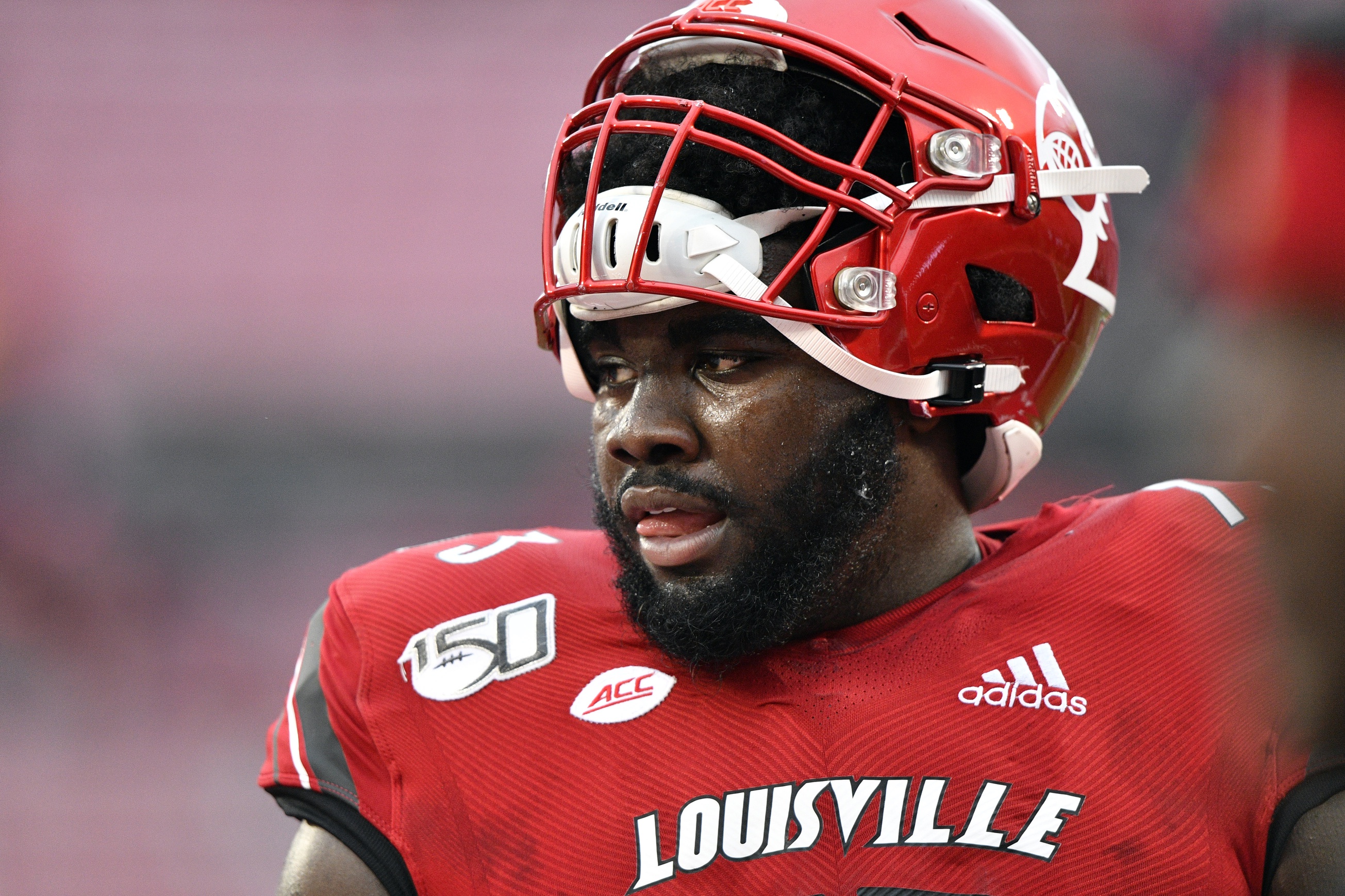
We have also found various scenarios for reaches. Most of them, of course, come in the first round.
Mekhi Becton to the Arizona Cardinals at No. 8
The Cardinals need protection for Kyler Murray, and according to our simulations, they are the most likely landing spot for Becton. This would be a match made in heaven if it weren’t for the problem that we are fairly low on him. If they want to go with a tackle, they should hope that Tristan Wirfs or Andrew Thomas drop that far. If they want or need to go another road, it’s almost a certainty that Jerry Jeudy, CeeDee Lamb or Isaiah Simmons are available at No. 8, all of whom would be better options.
Derrick Brown to the Jacksonville Jaguars at No. 9
Brown to Jacksonville seems like a natural pairing in this year’s draft, but the value simply isn’t there. In the final iteration of Mike Renner’s big board, Brown is not even the top interior defender anymore, and the importance of the interior position doesn’t justify taking him in the top 10.
While Simmons would be a home run at this spot, he is unlikely to fall this far. Therefore, the Jaguars would be better off with a wide receiver, offensive tackle or they could even take a shot at cornerbacks C.J. Henderson or Kristian Fulton, given the likelihood that Okudah is off the board by No. 9.
K’Lavon Chaisson to the Atlanta Falcons at No. 16 or Dallas Cowboys at No. 17 and Yetur Gross-Matos to the Seattle Seahawks at No. 27 or Tennessee Titans at No. 29
Chaisson is another player who is supposed to go higher than we believe he should, and the teams primed to reach for him are the Falcons or Cowboys, who both have a need for an edge rusher and draft directly when his range begins. He is supposed to make it to the Falcons 82% of the time. If this happens, can the Falcons and Cowboys resist drafting a player who fills a need but who also plays an over-drafted position?
The same holds for Gross-Matos roughly 10 spots later, with the Seahawks and Titans being the most likely candidates for a reach.
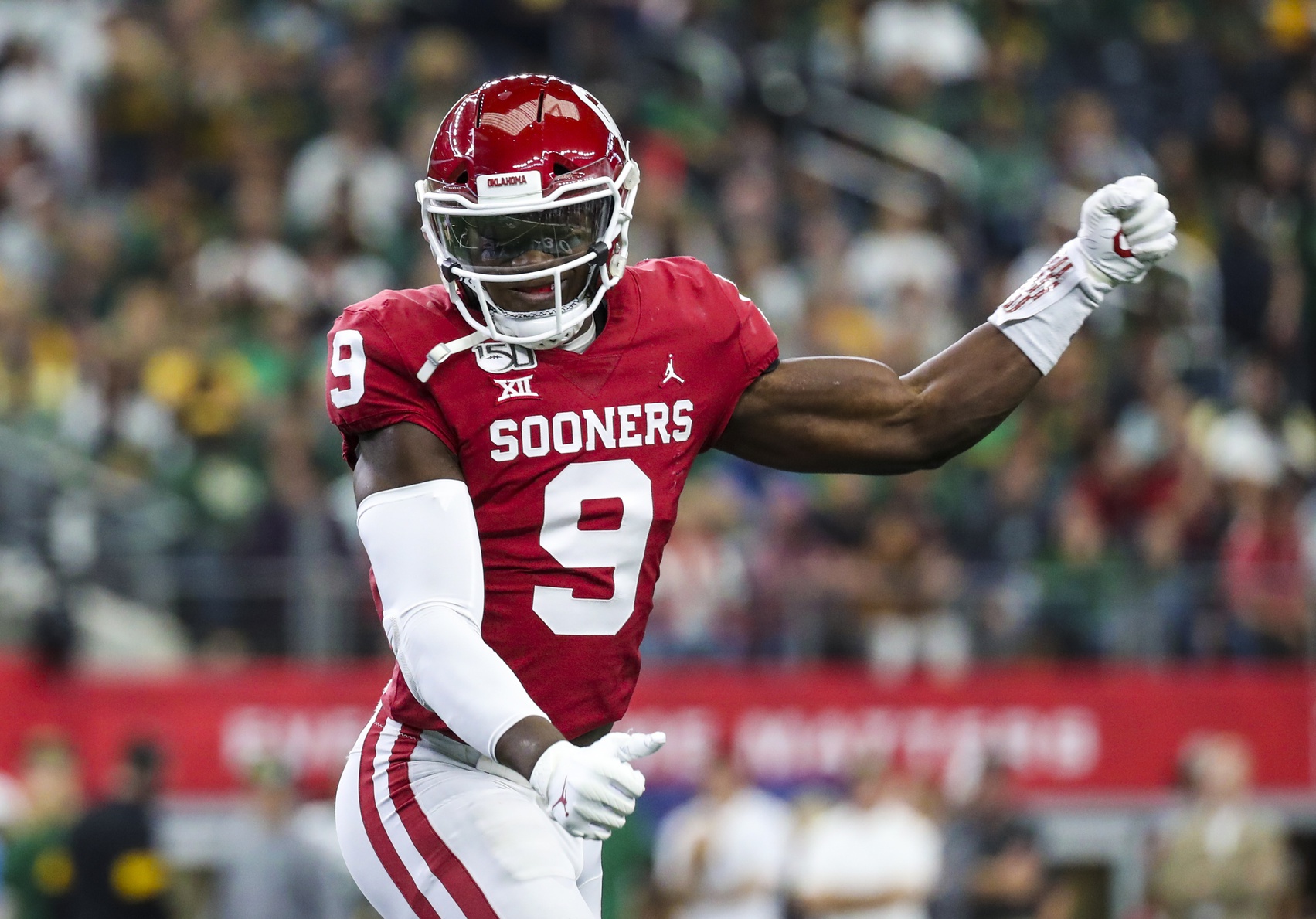
Kenneth Murray to the Philadelphia Eagles at No. 21 or Baltimore Ravens at No. 28
Both of these teams also have a need at wide receiver, and (especially for the Eagles) it’s tough to imagine they would pass on one for Murray. However, according to our simulations, the Eagles and Ravens are the most likely teams to reach for a linebacker with too many negatives in coverage.
Cesar Ruiz or Austin Jackson to the Cincinnati Bengals at No. 33
We’ve learned that the Bengals could land a steal at the safety position with Grant Delpit. However, they might also be tempted to help Joe Burrow with better protection. While this should definitely be on their agenda, the value isn’t here at this point. If they insist on strengthening their offensive line on Day 2, they should consider trading down and adding an additional draft pick, thereby obtaining more shots at a good pass-protector.
Conclusion
Nobody knows what will happen on draft day, as surprising picks — like Clelin Ferrell going fourth overall just last year or Terrell Edmunds being drafted in the first round in 2018 — happen almost every year. Nevertheless, using data to simulate what might happen is fun and can yield some insights as long as one acknowledges the uncertainty that’s inherent in both predicting the draft and predicting the future of draft prospects.
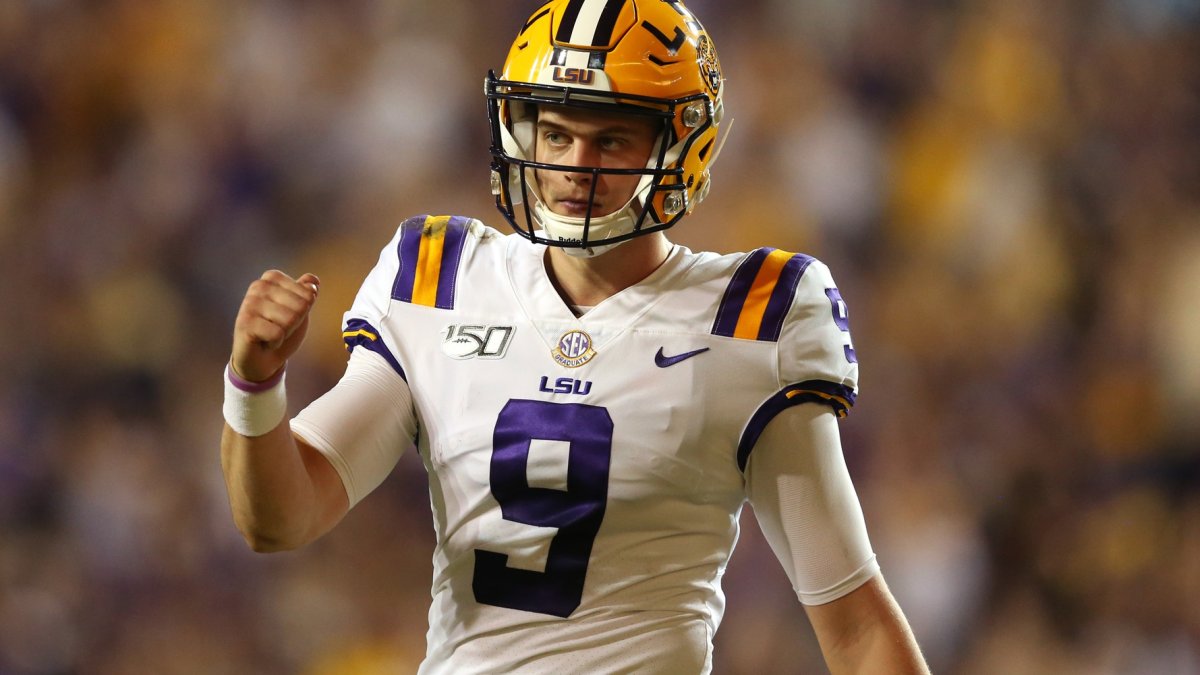


 © 2025 PFF - all rights reserved.
© 2025 PFF - all rights reserved.